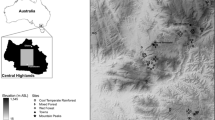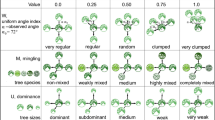Abstract
We studied the influence of environmental heterogeneity and dispersalprocesses on mesoscale distribution patterns of understorey plants in a 330ha ancient, managed temperate forest area. Similarity matrixregression analysis showed that overall species similarity was affected bysite(the two disjunct halves of the forest area), spatial autocorrelation at the100m scale, edaphic conditions, stand type and stand structure, andthe occurrence of open areas, but not by stand age or topography. Usingautologistic regression we analysed the influence of clumping, site, edaphicconditions, stand composition, open areas, and stand structure on theindividualdistribution patterns of the 60 most abundant species. Only five species haddistributions that were not significantly related to any of the explanatoryvariables. A large number of species showed significant, and often differing,relationships to at least one of the environmental parameters. At least 20species exhibited clumping at the 100 m scale that was independentof the environmental parameters. Principal coordinate analysis and an analysisusing the Ellenberg ecological indicator values suggested that no importantgradients had been overlooked. Dispersal ability (estimated from dispersalmode)and clumping independent of environmental heterogeneity were related. Poordispersers exhibited stronger clumping at the 100 m scale thangooddispersers. Our results support the joint importance of environmentalheterogeneity and dispersal processes in shaping the mesoscale distributionpatterns of forest herbs. We conclude that the distribution of plant species,and species coexistence and species composition in plant communities, cannot beexplained without simultaneously considering environmental heterogeneity anddispersal.
Similar content being viewed by others
References
Amezaga I. and Onaindia M. 1997. The effect of evergreen and deciduous coniferous plantations on the field layer and seed bank of native woodlands. Ecography 20: 308-318.
Beatty S.W. 1984. Influence of microtopography and canopy species on spatial patterns of forest understory plants. Ecol. 65: 1406-1419.
Bossuyt B., Hermy M. and Deckers J. 1999. Migration of herbaceous plant species across ancient-recent forest ecotones in central Belgium. J. Ecol. 87: 628-638.
Brown J.H. 1984. On the relationship between abundance and distribution of species. Am. Naturalist 124: 255-279.
Brunet J. and von Oheimb G. 1998. Migration of vascular plants to secondary woodlands in southern Sweden. J. Ecol. 86: 429-438.
Bruun H.H. and Fritzbøger B. 1999. Historiske forandringer i hus-dyrbruget har medført faldende artsrigdom i skove, enge og overdrev. URT 23: 84-97.
Cadenasso M.L. and Pickett S.T.A. 2000. Linking forest edge structure to edge function: mediation of herbivore damage. J. Ecol. 88: 31-44.
Cain M.L., Damman H. and Muir A. 1998. Seed dispersal and the Holocene migration of woodland herbs. Ecol. Monographs 68: 325-347.
Casgrain P. 1998. Permute! version 3.4 alpha. User's manual. Départment de sciences biologiques, Université de Montréal, Montréal, Canada.
Casgrain P. and Legendre P. 2000. The R package for Multivariate and Spatial Analysis. Version 4.0 (development release 2). User's Manual. Département de sciences biologiques, Université de Montréal, Montréal, Canada.
Clark D.B., Clark D.A. and Read J.M. 1998a. Edaphic variation and mesoscale distribution of tree species in a neotropical rain forest. J. Ecol. 86: 101-112.
Clark J.S., Macklin E. and Wood L. 1998b. Stages and spatial scales of recruitment limitation in southern Appalachian forests. Ecol. Monographs 68: 213-235.
Clark D.B., Palmer M.W. and Clark D.A. 1999a. Edaphic factors and the landscape-scale distributions of tropical rain forest trees. Ecol. 80: 2662-2675.
Clark J.S., Silman M., Kern R., Macklin E. and HilleRisLambers J. 1999b. Seed dispersal near and far: patterns across temperate and tropical forests. Ecol. 80: 1475-1494.
Condit R., Ashton P.S., Baker P., Bunyavejchewin S., Gunatilleke S., Gunatilleke N. et al. 2000. Spatial patterns in the distribution of tropical tree species. Science 288: 1414-1418.
Connell J.H. 1978. Diversity in tropical rain forests and coral reefs. Science 199: 1302-1310.
Cornell H.V. and Lawton J.H. 1992. Species interactions, local and regional processes, and limits to the richness of ecological communities: a theoretical perspective. J. Animal Ecol. 61: 1-12.
Crawley M.J. 1997. The structure of plant communities. In: Crawley M.J. (ed.), Plant Ecology. Blackwell Scientific Ltd., Oxford, pp. 475-531.
Donohue K., Foster D.R. and Motzkin G. 2000. Effects of the past and the present on species distribution: land-use history and demography of wintergreen. J. Ecol. 88: 303-316.
Ehrlén J. and Eriksson O. 2000. Dispersal limitation and patch occupancy in forest herbs. Ecol. 81: 1667-1674.
Ellenberg H. 1988. Vegetation Ecology of Central Europe. Cambridge University Press, Cambridge.
Eriksson O. 1996. Regional dynamics of plants: a review of evidence for remnant, source-sink and metapopulations. Oikos 77: 248-258.
Eriksson O. and Ehrlén J. 1992. Seed and microsite limitation of recruitment in plant populations. Oecol. 91: 360-364.
Eriksson O. and Jacobsson A. 1998. Abundance, distribution and life histories of grassland plants: a comparative study of 81 species. J. Ecol. 86: 922-933.
Falinski J.B. 1986. Vegetation Dynamics in Temperate Lowland Primeval Forests - Ecological Studies in Bialowieza Forest. Dr W. Junk Publishers, Dordrecht, the Netherlands.
Graae B.J. 2000. The impact of forest continuity on the flora in Danish deciduous forests. phd, University of Copenhagen.
Graae B.J. The effect of landscape fragmentation and forest continuity on forest floor species in two regions of Denmark. J. Veget. Sci. (in press).
Graae B.J. and Sunde P.B. 2000. The impact of forest continuity and management on forest floor vegetation evaluated by species traits. Ecography 23: 720-731.
Granat H.J. 1994. Lokalitetskortlægning af Hestehave Skov og Ringelmose Skov ved Kalø. Internal Report # 20. Geological Insitute, Laboratory of Physical Geography, University of Aarhus, Aarhus, Denmark.
Grashof-Bokdam C.J. and Geertsema W. 1998. The effect of isolation and history on colonization patterns of plant species in secondary woodland. J. Biogeography 25: 837-846.
Hanley T.A. and Brady W.W. 1996. Understory species composition and production in old-growth western hemlock - Sitka spruce forest of southeastern Alaska. Can. J. Botany 75: 574-580.
Hansen K. (ed.) 1984. Dansk Feltflora. Gyldendalske Boghandel, Nordisk Forlag A/S, Copenhagen, Denmark.
Hanski I. 1998. Metapopulation dynamics. Nature 396: 41-49.
Hensher D.A. and Johnson L.W. 1981. Applied Discrete-Choice Modelling. Halsted Press, a Division of John Wiley & Sons, Inc., New York.
Hermy M., Honnay O., Firbank L., Grashof-Bokdam C. and Lawesson J. 1999. An ecological comparison between ancient and other forest plant species of Europe, and the implications for forest conservation. Biol. Conservation 91: 9-22.
Honnay O., Hermy M. and Coppin P. 1999. Impact of habitat quality on forest plant species colonization. Forest Ecol. Manag. 115: 157-170.
Hubbell S.P. 1997. A unified theory of biogeography and relative species abundance and its application to tropical rain forests and coral reefs. Coral Reefs 16: S9-S21.
Hubbell S.P. and Foster R.B. 1986. Biology, chance, and history of tropical rain forest tree communities. In: Diamond J. and Case T.J. (eds), Community Ecology. Harper & Row Publishers, New York, pp. 314-329.
Hubbell S.P., Foster R.B., O'Brien S.T., Harms K.E., Condit R., Wechsler B. et al. 1999. Light-gap disturbances, recruitment limitation, and tree diversity in a Neotropical forest. Science 283: 554-557.
Hurtt G.C. and Pacala P.W. 1995. The consequences of recruitment limitation: reconciling chance, history and competitive differences between plants. J. Theor. Biol. 176: 1-12.
Kadmon R. and Shmida A. 1990. Spatiotemporal demopgraphic processes in plant populations: an approach and a case study. Am. Naturalist 135: 382-397.
Kirby K.J. 1988. Changes in the ground flora under plantations in ancient woodland sites. Forestry 61: 317-338.
Legendre P., Lapointe F.-J. and Casgrain P. 1994. Modeling brain evolution from behaviour: a permutation regression approach. Evolution 48: 1487-1499.
Legendre P. and Legendre L. 1998. Numerical Ecology. Developments in Environmental Modelling. Elsevier, Amsterdam, the Netherlands.
Legendre P. and Vaudor A. 1991. The R Package: Multidimensional Analysis, Spatial Analysis. Départment de sciences biologiques, Université de Montréal, Montréal, Canada.
Lehman C.L. and Tilman D. 1997. Competition in spatial habitats. In: Tilman D. and Kareiva P. (eds), Spatial Ecology: The Role of Space in Population Dynamics and Interspecific Interactions. Princeton University Press, Princeton, New Jersey, pp. 185-203.
Matlack G.R. 1994a. Plant species migration in a mixed-history forest landscape in eastern North America. Ecol. 75: 1491-1502.
Matlack G.R. 1994b. Vegetation dynamics of the forest edge - trends in space and successional time. J. Ecol. 82: 113-123.
Meier A.J., Bratton S.P. and Duffy D.C. 1995. Possible ecological mechanisms for loss of vernal-herb diversity in logged eastern deciduous forests. Ecol. Applic. 5,: 935-946.
Motzkin G., Wilson P., Foster D.R. and Allen A. 1999. Vegetation patterns in heterogenous landscapes: The importance of history and environment. J. Veget. Sci. 10: 903-920.
Nathan R. and Muller-Landau H.C. 2000. Spatial patterns of seed dispersal, their determinants and consequences for recruitment. Trends Ecol. Evol. 15: 278-285.
Palmer M.W. 1990. Spatial scale and patterns of species-environment relationships in hardwood forests of the North Carolina Piedmont. Coenoses 5: 79-87.
Peterken G.F. 1996. Natural Woodland: Ecology and Conservation in Northern Temperate Regions. Cambridge University Press, Cambridge.
Peterken G.F. and Game M. 1984. Historical factors affecting the number and distribution of vascular plant species in the woodlands of central Lincolnshire. J. Ecol. 72: 155-182.
Primack R.B. and Miao S.L. 1992. Dispersal can limit local plant distribution. Conservat. Biol. 6: 513-519.
Reed R.A., Peet R.K., Palmer M.W. and White P.S. 1993. Scale dependence of vegetation-environment correlations: a case study from a North Carolina piedmont woodland. J. Veget. Sci. 4: 329-340.
SAS Institute 1994. JMP Statistics and Graphics Guide. Version 3 of JMP. SAS Institute Inc., Cary.
Scheiner S.M. and Rey-Benayas J.M. 1997. Placing empirical limits on metapopulation models for terrestrial plants. Evol. Ecol. 11: 275-288.
Shmida A. and Ellner S. 1984. Coexistence of plant species with similar niches. Vegetatio 58: 29-55.
Skov F. 1997. Stand and neighbourhood parameters as determinants of plant species richness in a managed forest. J. Veget. Sci. 8: 573-578.
Skov F. 2000. Distribution of plant functional attributes in a managed forest in relation to neighbourhood structure. Plant Ecol. 146: 121-130.
Skov F., Berthelsen J.P., Andersen T.Q., Asferg T., Carstensen H., Christensen M. et al. 1997. Basismonitering af Kaløskovene 1993. Arbejdsrapport fra DMU nr. 45. Danmarks Miljøundersøgelser, Kalø, Denmark.
Smith P.A. 1994. Autocorrelation in logistic regression modelling of species' distributions. Glob. Ecol. Biogeog. Letters 4: 47-61.
Svenning J.-C. 1999. Microhabitat specialization in a species-rich palm community in Amazonian Ecuador. J. Ecol. 87: 55-65.
Svenning J.-C. 2001. Environmental heterogeneity, recruitment limitation, and the mesoscale distribution of palms in a tropical montane rain forest (Maquipucuna, Ecuador). J. Trop. Ecol. 17: 97-113.
Tilman D. 1994. Competition and biodiversity in spatially structured habitats. Ecol. 75: 2-16.
Tilman D. 1997. Community invasibility, recruitment limitation, and grassland biodiversity. Ecol. 78: 81-92.
Turnbull L.A., Crawley M.J. and Rees M. 2000. Are plant populations seed-limited? A review of seed sowing experiments. Oikos 88: 225-238.
Whitney C.G. and Foster D.R. 1988. Overstorey composition and age as determinants of the understorey flora of woods of central New England. J. Ecol. 76: 867-876.
Willson M.F. 1993. Dispersal mode, seed shadows, and colonization patterns. Vegetatio 107/108: 261-280.
Wu H. 1994. Regression models for spatial binary data with application to the distribution of plant species. phd, Department of Statistics, Florida State University, Gainesville.
Wu H. and Huffer F.W. 1997. Modelling the distribution of plant species using the autologistic regression model. Envir. Ecol. Statistics 4: 49-64.
Wulf M. 1997. Plant species as indicators of ancient woodland in northwestern Germany. J. Veget. Sci. 8: 635-642.
Zar J.H. 1996. Biostatistical Analysis. Prentice Hall Inc, Upper Saddle River, New Jersy.
Zobel M. 1997. The relative role of species pools in determining plant species richness: an alternative explanation of species co-existence? Trends Ecol. Evol. 12: 266-269.
Author information
Authors and Affiliations
Rights and permissions
About this article
Cite this article
Svenning, JC., Skov, F. Mesoscale distribution of understorey plants in temperate forest (Kalø, Denmark): the importance of environment and dispersal. Plant Ecology 160, 169–185 (2002). https://doi.org/10.1023/A:1015885321263
Issue Date:
DOI: https://doi.org/10.1023/A:1015885321263




